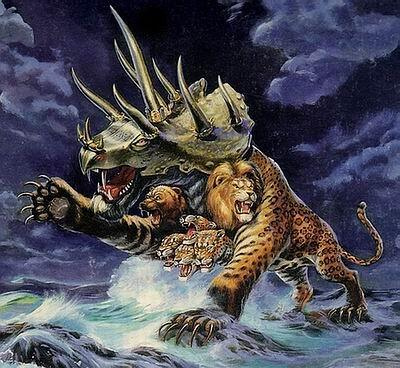Rev 11:6 These have authority to shut up the heaven, that it may not rain in the days of their prophecy. And they have authority over waters to turn them to blood, and to strike the earth with every plague, as often as they desire.
Rev 11:7 And when they complete their testimony, the beast coming up out of the abyss will make war against them and will overcome them and kill them.
Rev 11:8 And their bodies will lie in the street of the great city, which spiritually is called Sodom and Egypt, where also our Lord was crucified.
Rev 11:9 And many of the peoples and tribes and tongues and nations will see their dead bodies three days and a half, and they will not allow their dead bodies to be put in tombs.
 |
| The Beast out of the Bottomless Pit |
(a) It has its origin from beneath - in the bottomless pit; the sea; the earth, Rev_11:7; Rev_13:1, Rev_13:11.
(b) It has great power, Rev_13:4, Rev_13:12; Rev_17:12-13.
(c) It claims and receives worship, Rev_13:3, Rev_13:12, Rev_13:14-15; Rev_14:9, Rev_14:11.
(d) It has a certain “seat” or throne from whence its power proceeds, Rev_16:10.
(e) It is of scarlet color, Rev_17:3.
(f) It receives power conferred upon it by the kings of the earth, Rev_17:13,
(g) It has a mark by which it is known, Rev_13:17; Rev_19:20.
(h) It has a certain “number”; that is, there are certain mystical letters or figures which so express its name that it may be known, Rev_13:17-18.
These things serve to characterize the “beast” as distinguished from all other things, and they are so numerous and definite, that it would seem to have been intended to make it easy to understand what was meant when the power referred to should appear. In regard to the origin of the imagery here, there can be no reasonable doubt that it is to be traced to Daniel, and that the writer here means to describe the same “beast” which Daniel refers to in Rev_7:7. The evidence of this must be clear to anyone who will compare the description in Daniel Rev. 7 with the minute details in the book of Revelation. No one, I think, can doubt that John means to carry forward the description ill Daniel, and to apply it to new manifestations of the same great and terrific power - the power of the fourth monarchy - on the earth. For full evidence that the representation in Daniel refers to the Roman power prolonged and perpetuated in the papal dominion, I must refer the reader to the notes on Dan_7:25. It may be assumed here that the opinion there defended is correct, and consequently it may be assumed that the “beast” of this book refers to the papal power.
That ascendeth out of the bottomless pit - See the notes on Rev_9:1. This would properly mean that its origin is the nether world; or that it will have characteristics which will show that it was from beneath. The meaning clearly is, that what was symbolized by the beast would have such characteristics as to show that it was not of divine origin, but had its source in the world of darkness, sin, and death. This, of course, could not represent the true church, or any civil government that is founded on principles which God approves. But if it represent a community pretending to be a church, it is an apostate church; if a civil community, it is a community the characteristics of which are that it is controlled by the spirit that rules over the world beneath. For reasons which we shall see in abundance in applying the descriptions which occur of the “beast,” I regard this as referring to that great apostate power which occupies so much of the prophetic descriptions - the papacy.
Shall make war against them - Will endeavor to exterminate them by force. This clearly is not intended to be a general statement that they would be persecuted, but to refer to the particular manner in which the opposition would be conducted. It would be in the form of “war”; that is, there would be an effort to destroy them by arms.
And shall overcome them - Shall gain the victory over them; conquer them - νικήσει αὐτοὺς nikēsei autous. That is, there will be some signal victory in which those represented by the two witnesses will he subdued.
And kill them - That is, an effect would be produced as if they were put to death. They would be overcome; would be silenced; would be apparently dead. Any event that would cause them to cease to bear testimony, as if they were dead, would be properly represented by this. It would not be necessary to suppose that there would be literally death in the ease, but that there would be some event which would be well represented by death - such as an entire suspension of their prophesying in consequence of force.
 |
| The temple Mount Jerusalem |

No comments:
Post a Comment